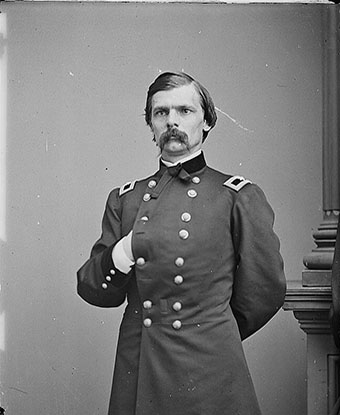Last updated: July 29, 2020
Person
George C. Strong

Library of Congress
George Crockett Strong was born in Stockbridge, Vermont on October 16, 1832. He was raised by an uncle in Easthampton, Masschusetts, attended Williston Seminary and Union College, then entered the US Military Academy and graduated fifth in his class in 1857. He served as a lieutenant of ordnance on General Irvin McDowell’s staff at the First Battle of Bull Run in 1861. Rising rapidly through the ranks, he served on the staffs of Generals George B. McClellan and Benjamin Butler. In 1862, he commanded two expeditions along the coast of Mississippi and was commissioned brigadier general of volunteers in November 1862.
On June 17, 1863, Strong reported to Saint Helena Island to join the Department of the South commanded by Major General Quincy A. Gillmore. He was placed in command of one of the brigades designated to spearhead the upcoming assault on Confederate positions defending Charleston located on Morris Island at the mouth of the harbor. Strong met Colonel Robert G. Shaw, the white commander of the 54th Massachusetts Regiment, composed of African Americans and black Canadian volunteers. By July 8th, Strong’s brigade had moved from Saint Helena and was in position on Folly Island to launch the attack on the southern end of Morris Island. Under supporting fire from Union artillery on Folly Island and Navy monitors and gunboats offshore, the amphibious assault began the morning of the 10th. By the end of the day, Confederate forces had been pushed back to Battery Wagner near the northern end of the island. Two-thirds of Morris Island was now in Union hands.
Despite the success of the attack, Strong did not order an attack on Battery Wagner until the next morning, July 11. Given time for the Confederates to receive reinforcements, who fought from a strong defensive work on a narrow front, the Union attack failed with considerable losses. On July 18, Strong ordered another assault on Wagner. This time he selected the 54th Massachusetts to lead the assault. It was dusk when the attack began. As the 54th advanced, it was met by murderous fire from Wagner. As those not cut down in the initial burst of fire reached the top of Wagner’s parapet, fierce hand-to-hand combat ensued. As Colonel Shaw stood on the top of the parapet, he was hit by several bullets and killed. As the 54th was beaten back, the two supporting regiments surged forward but were also repelled. Strong personally led the final attempt but was seriously wounded by grape shot in the thigh and was forced to pull the remnants of his brigade back. By 1:00 am on July 19, the battle was over. The second assault on Battery Wagner had failed with heavy Union losses. What followed was a siege that ended when Confederates abandoned Battery Wagner on the night of September 6, 1863.
Brigadier General Strong was evacuated to New York City for treatment of his wound. During his trip, he contracted tetanus and died in New York on July 20, 1863. He was promoted to major general the day after he died. He is buried in Green-Wood Cemetery in Brooklyn, New York. A monument dedicated to his memory stands there.
